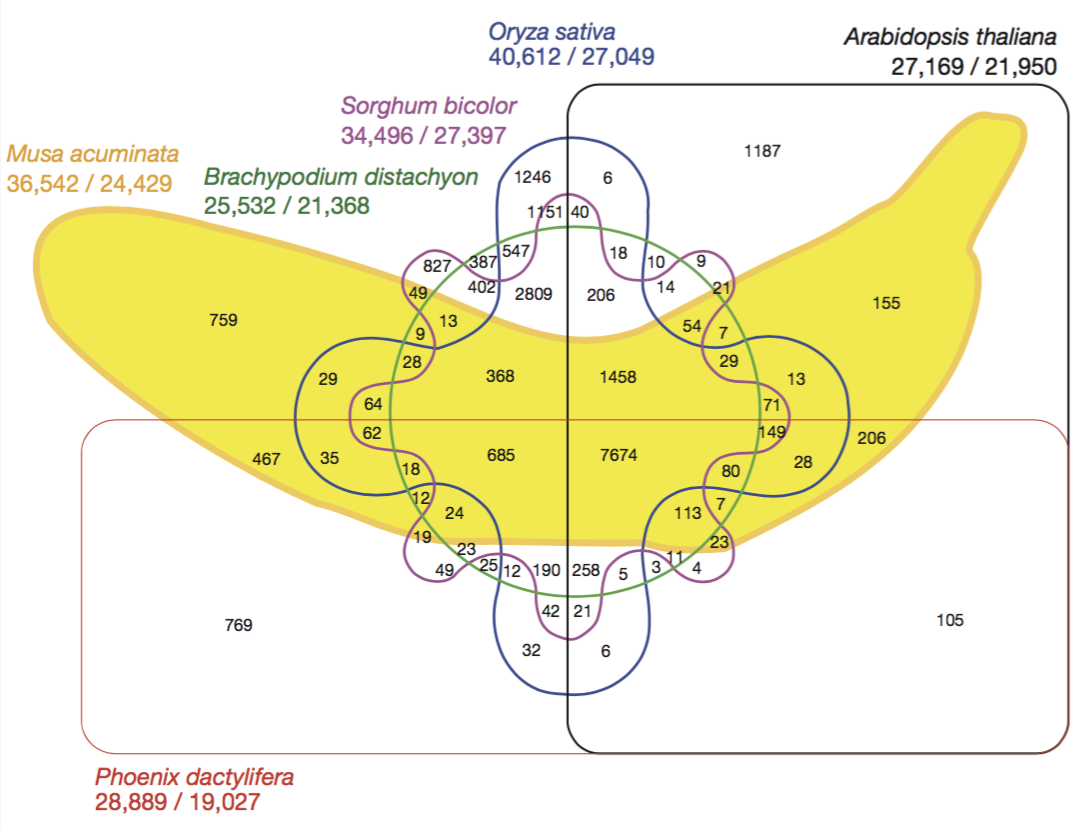

Venn Diagram
definition - mistake - related - code
A Venn diagram (also called primary diagram, set diagram
or logic diagram) is a diagram that shows all possible logical
relationships between a finite collection of different sets.
Each set is represented by a circle. The circle size sometimes represents the importance of the group but not always. The groups are usually overlapping: the size of the overlap represents the intersection between both groups.
Here is an example showing the number of shared words in the lyrics of 3 famous french singers: (Nekfeu, Booba) and Georges Brassens. You can read more about this story here.
# Libraries
library(tidyverse)
library(hrbrthemes)
library(tm)
library(proustr)
# Load dataset from github
data <- read.table("https://raw.githubusercontent.com/holtzy/data_to_viz/master/Example_dataset/14_SeveralIndepLists.csv", header=TRUE)
to_remove <- c("_|[0-9]|\\.|function|^id|script|var|div|null|typeof|opts|if|^r$|undefined|false|loaded|true|settimeout|eval|else|artist")
data <- data %>% filter(!grepl(to_remove, word)) %>% filter(!word %in% stopwords('fr')) %>% filter(!word %in% proust_stopwords()$word)
# library
library(VennDiagram)
#cMake the plot
venn.diagram(
x = list(
data %>% filter(artist=="booba") %>% select(word) %>% unlist() ,
data %>% filter(artist=="nekfeu") %>% select(word) %>% unlist() ,
data %>% filter(artist=="georges-brassens") %>% select(word) %>% unlist()
),
category.names = c("Booba (1995)" , "Nekfeu (663)" , "Brassens (471)"),
filename = 'IMG/venn.png',
output = TRUE ,
imagetype="png" ,
height = 480 ,
width = 480 ,
resolution = 300,
compression = "lzw",
lwd = 1,
col=c("#440154ff", '#21908dff', '#fde725ff'),
fill = c(alpha("#440154ff",0.3), alpha('#21908dff',0.3), alpha('#fde725ff',0.3)),
cex = 0.5,
fontfamily = "sans",
cat.cex = 0.3,
cat.default.pos = "outer",
cat.pos = c(-27, 27, 135),
cat.dist = c(0.055, 0.055, 0.085),
cat.fontfamily = "sans",
cat.col = c("#440154ff", '#21908dff', '#fde725ff'),
rotation = 1
)
Here, it is easy to understand that Booba used 1995 unique words in the dataset. 44 of them were also used by Brassens and Nekfeu, 126 only shared with Nekfeu only.
A venn diagram makes a really good work to study the intersection between 2 or 3 sets. It becomes very hard to read with more groups than that and thus must be avoided.
Here is a famous example: a six-set venn diagram published in Nature that shows the relationship between the banana’s genome and the genome of five other species.

Even if this figure is quite attractive, it is really hard to extract any information from it. Here is a workaround.
To visualize the intersection between more than 3 sets, the best option is to use a UpSet plot.
Here is an example provided by the UpsetR R library that displays the banana genome information seen before. The total size of each set is represented on the left barplot. Every possible intersection is represented by the bottom plot, and their occurence is shown on the top barplot.
# Specific library
library(UpSetR)
# Dataset
input <- c(
M.acuminata = 759,
P.dactylifera = 769,
A.thaliana = 1187,
O.sativa = 1246,
S.bicolor = 827,
B.distachyon = 387,
"P.dactylifera&M.acuminata" = 467,
"O.sativa&M.acuminata" = 29,
"A.thaliana&O.sativa" = 6,
"S.bicolor&A.thaliana" = 9,
"O.sativa&P.dactylifera" = 32,
"S.bicolor&P.dactylifera" = 49,
"S.bicolor&M.acuminata" = 49,
"B.distachyon&O.sativa" = 547,
"S.bicolor&O.sativa" = 1151,
"B.distachyon&A.thaliana" = 10,
"B.distachyon&M.acuminata" = 9,
"B.distachyon&S.bicolor" = 402,
"M.acuminata&A.thaliana" = 155,
"A.thaliana&P.dactylifera" = 105,
"B.distachyon&P.dactylifera" = 25,
"S.bicolor&O.sativa&P.dactylifera" = 42,
"B.distachyon&O.sativa&P.dactylifera" = 12,
"S.bicolor&O.sativa&B.distachyon" = 2809,
"B.distachyon&O.sativa&A.thaliana" = 18,
"S.bicolor&O.sativa&A.thaliana" = 40,
"S.bicolor&B.distachyon&A.thaliana" = 14,
"O.sativa&B.distachyon&M.acuminata" = 28,
"S.bicolor&B.distachyon&M.acuminata" = 13,
"O.sativa&M.acuminata&P.dactylifera" = 35,
"M.acuminata&S.bicolor&A.thaliana" = 21,
"B.distachyon&M.acuminata&A.thaliana" = 7,
"O.sativa&M.acuminata&A.thaliana" = 13,
"M.acuminata&P.dactylifera&A.thaliana" = 206,
"P.dactylifera&A.thaliana&S.bicolor" = 4,
"O.sativa&A.thaliana&P.dactylifera" = 6,
"S.bicolor&O.sativa&M.acuminata" = 64,
"S.bicolor&M.acuminata&P.dactylifera" = 19,
"B.distachyon&A.thaliana&P.dactylifera" = 3,
"B.distachyon&M.acuminata&P.dactylifera" = 12,
"B.distachyon&S.bicolor&P.dactylifera" = 23,
"M.acuminata&B.distachyon&S.bicolor&A.thaliana" = 54,
"P.dactylifera&S.bicolor&O.sativa&M.acuminata" = 62,
"B.distachyon&O.sativa&M.acuminata&P.dactylifera" = 18,
"S.bicolor&B.distachyon&O.sativa&A.thaliana" = 206,
"B.distachyon&M.acuminata&O.sativa&A.thaliana" = 29,
"O.sativa&M.acuminata&A.thaliana&S.bicolor" = 71,
"M.acuminata&O.sativa&P.dactylifera&A.thaliana" = 28,
"B.distachyon&M.acuminata&O.sativa&A.thaliana" = 7,
"B.distachyon&S.bicolor&P.dactylifera&A.thaliana" = 11,
"B.distachyon&O.sativa&P.dactylifera&A.thaliana" = 5,
"A.thaliana&P.dactylifera&S.bicolor&O.sativa" = 21,
"M.acuminata&S.bicolor&P.dactylifera&A.thaliana" = 23,
"M.acuminata&B.distachyon&S.bicolor&P.dactylifera" = 24,
"M.acuminata&O.sativa&S.bicolor&B.distachyon" = 368,
"P.dactylifera&B.distachyon&S.bicolor&O.sativa" = 190,
"P.dactylifera&B.distachyon&S.bicolor&O.sativa&A.thaliana" = 258,
"P.dactylifera&M.acuminata&S.bicolor&B.distachyon&O.sativa" = 685,
"M.acuminata&S.bicolor&B.distachyon&O.sativa&A.thaliana" = 1458,
"S.bicolor&M.acuminata&P.dactylifera&O.sativa&A.thaliana" = 149,
"B.distachyon&M.acuminata&P.dactylifera&O.sativa&A.thaliana" = 80,
"M.acuminata&S.bicolor&B.distachyon&P.dactylifera&A.thaliana" = 113,
"M.acuminata&S.bicolor&B.distachyon&P.dactylifera&O.sativa&A.thaliana" = 7674
)
# Plot
upset(fromExpression(input), nintersects = 40, nsets = 6, order.by = "freq", decreasing = T, mb.ratio = c(0.6, 0.4),
number.angles = 0, text.scale = 1.1, point.size = 2.8, line.size = 1)
Here, it gets easy to understand that the vast majority of genes is shared between all plants, and which intersection are the biggest.
Data To Viz is a comprehensive classification of chart types organized by data input format. Get a high-resolution version of our decision tree delivered to your inbox now!

A work by Yan Holtz for data-to-viz.com